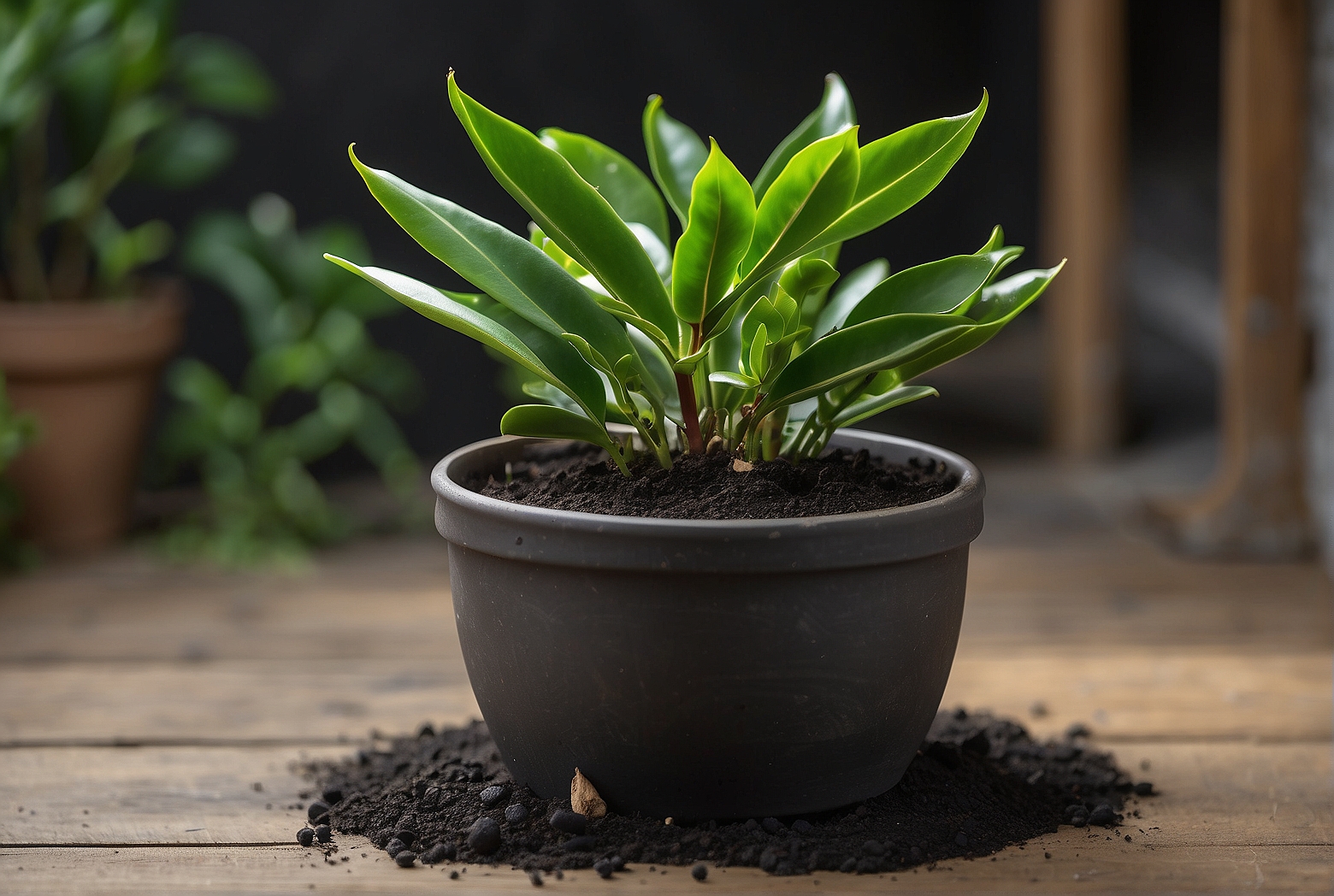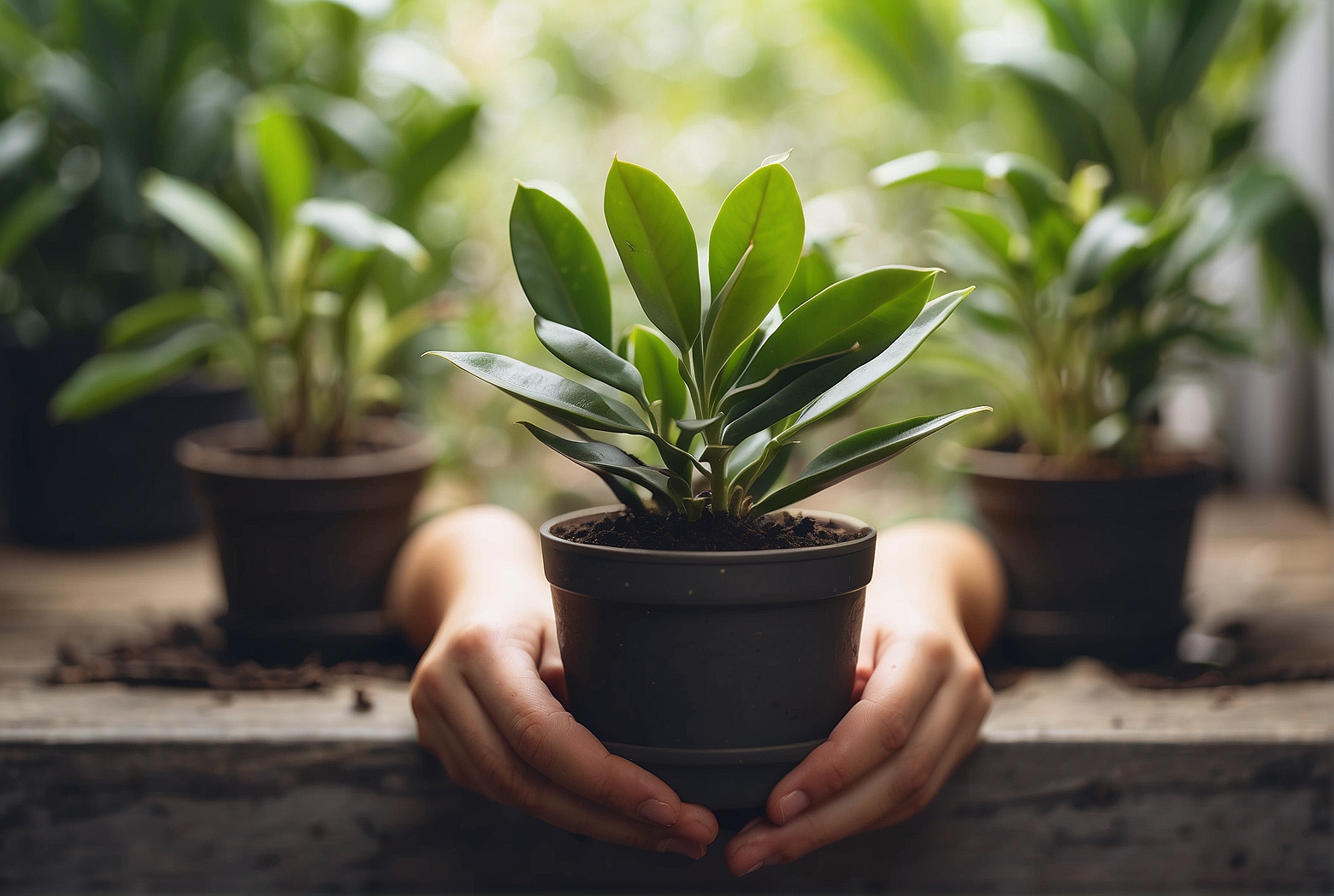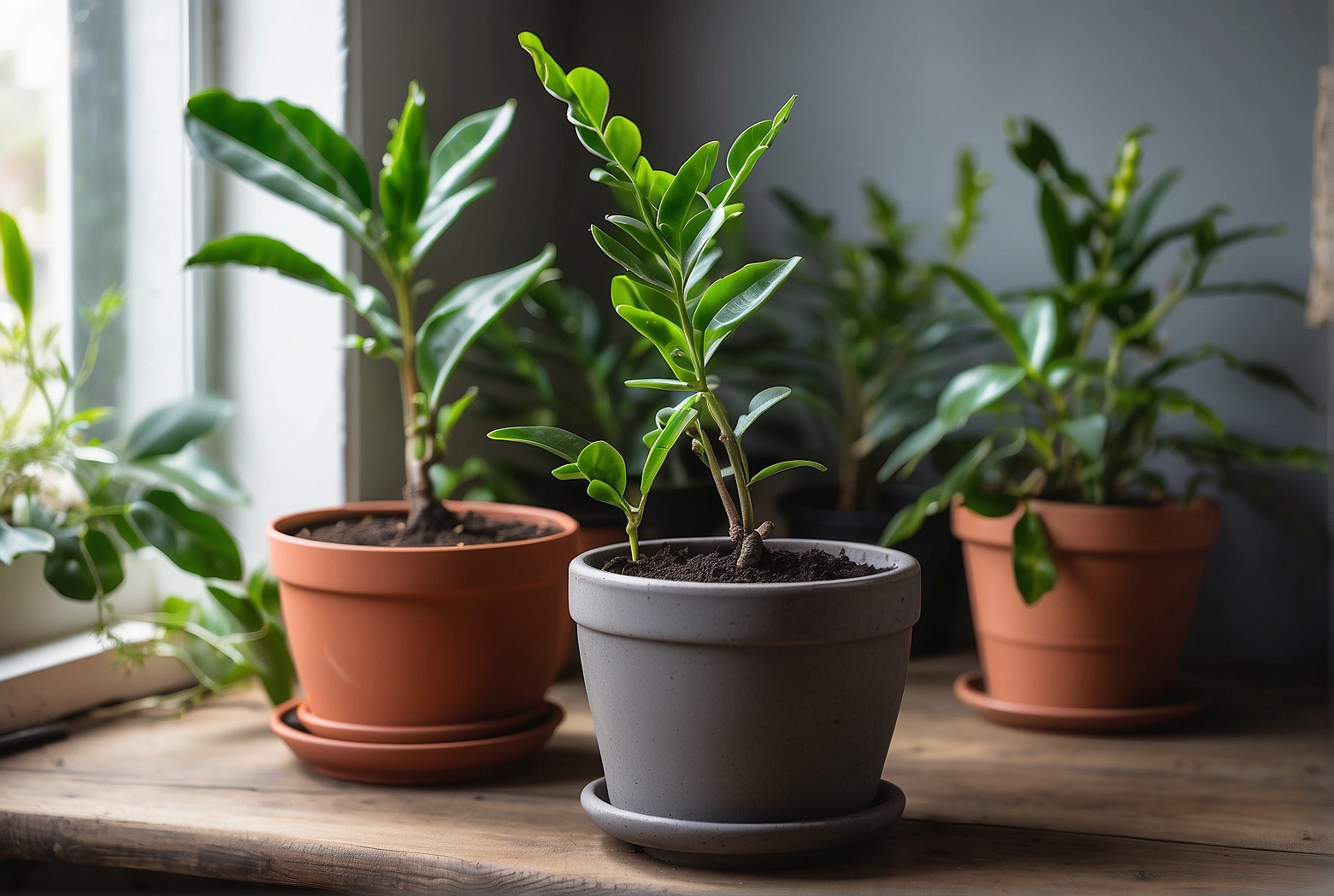Last Updated on April 14, 2024 by Tony Manhart
Have you ever wondered how to propagate a ZZ plant in soil? Look no further, because this article is here to provide you with a complete guide on successfully propagating a ZZ plant in soil. Whether you’re a beginner or an experienced plant enthusiast, this guide has got you covered. Learn the step-by-step process, helpful tips, and tricks to ensure that your ZZ plant cuttings thrive and grow into healthy, beautiful plants. Get ready to embark on a rewarding journey of propagating and expanding your ZZ plant collection in soil.
Preparing the Soil
When it comes to propagating a ZZ plant in soil, one of the first and most crucial steps is preparing the soil. Choosing the right soil is essential for providing the necessary nutrients and support for the cuttings to root and grow successfully. A well-draining soil mix is highly recommended to prevent waterlogged conditions that can lead to root rot.
Choosing the Right Soil
The ideal soil for propagating ZZ plants is a mixture of peat moss, perlite, and a high-quality potting mix. Peat moss helps retain moisture while still allowing excess water to drain away, while perlite aids in improving drainage and preventing compacted soil. A good potting mix ensures a balanced combination of organic matter and nutrients that promote healthy growth.
Mixing Soil Components
To create the perfect soil mix for propagating ZZ plants, start by combining equal parts peat moss and perlite. Mix these two components thoroughly to ensure a well-distributed blend. Once the peat moss and perlite are thoroughly mixed, add the potting mix gradually while continuing to blend until you achieve a well-balanced soil mixture. Remember to maintain the right moisture level throughout the mixing process to prevent excessive dryness or waterlogging.

Adding Organic Matter
In addition to the basic soil components, incorporating organic matter into the mix can provide additional nutrients and support for the ZZ plant cuttings. Organic matter such as well-rotted compost or aged manure enriches the soil with beneficial microorganisms and essential nutrients. Add a small amount of organic matter to the soil mix and blend it well to ensure even distribution. This will help create a fertile environment for the cuttings to develop healthy roots.
Taking Cuttings
Once you have prepared the soil, it’s time to gather stem cuttings from a healthy ZZ plant. Taking cuttings is a common and effective method of propagating many plants, including the ZZ plant.
Selecting Healthy Stem Cuttings
When selecting stem cuttings for propagation, it’s important to choose healthy and mature stems. Look for stems that are about 4-6 inches long and have a few sets of leaves. Avoid selecting stems that show signs of disease, pests, or physical damage. Healthy stems have vibrant green coloration and firm texture.
Preparing the Cuttings
To prepare the cuttings for propagation, start by removing the lower leaves from the stem, leaving only a few sets of leaves at the top. This helps reduce moisture loss through transpiration and focuses the plant’s energy on root development. If there are any flower buds present on the stem, it’s best to remove them as they can divert energy away from root growth.

Applying Rooting Hormone
To enhance the chances of successful rooting, it’s recommended to apply rooting hormone to the cuttings. Rooting hormone contains plant growth hormones that stimulate root development and increase the chances of successful propagation. Dip the lower end of the cuttings into the rooting hormone, ensuring that the powder or gel coats the stem’s base. Gently tap off any excess hormone and insert the treated cuttings into the prepared soil mix.
Creating Optimal Conditions
Creating optimal conditions for the ZZ plant cuttings is vital for their successful growth and development. Paying attention to factors such as lighting, temperature, and humidity will greatly influence the propagation process.
Providing Adequate Lighting
ZZ plants thrive in bright, indirect light conditions. When propagating the cuttings, place them in an area that receives bright, indirect sunlight. Direct sunlight can be too intense and may scorch the young, delicate leaves. If natural light is not sufficient, you can use fluorescent grow lights placed about 6-12 inches away from the cuttings.
Maintaining Proper Temperature
Maintaining the right temperature is crucial in promoting root development and overall growth of the cuttings. ZZ plants prefer temperatures between 65-75°F (18-24°C) during the propagation stage. Avoid exposing the cuttings to extreme temperature fluctuations or drafts, as they can stress the plants and hinder their growth.
Ensuring Humidity Levels
To create a favorable environment for the ZZ plant cuttings, it’s important to maintain adequate humidity levels. Higher humidity helps prevent excessive moisture loss and aids in root development. You can increase humidity by placing the cuttings on a tray filled with water and pebbles, using a humidifier, or covering the pots with clear plastic bags. Regularly misting the cuttings with water can also help maintain humidity levels.
Planting the Cuttings
Planting the cuttings in suitable containers is the next step in the propagation process. Properly chosen containers and thorough preparation will provide the cuttings with the necessary space and support for healthy growth.
Choosing Suitable Containers
Selecting the right containers is crucial for providing sufficient space and suitable growing conditions for the ZZ plant cuttings. Use containers that have drainage holes at the bottom to ensure proper water drainage and prevent waterlogging. It’s recommended to choose containers that are slightly larger than the size of the cuttings to allow room for root development.
Preparing the Containers
Before planting the cuttings, it’s important to prepare the containers appropriately. Start by sterilizing the containers with a diluted bleach solution to eliminate any potential disease-causing pathogens. Rinse the containers thoroughly with clean water and allow them to dry completely before proceeding. Once dry, fill the containers with the prepared soil mix, leaving about an inch of space at the top.
Planting the Cuttings
With the containers prepared, it’s time to plant the ZZ plant cuttings. Make a small hole in the soil mix using a pencil or your finger, and gently insert the base of the cuttings into the hole. Ensure that the cuttings are inserted deep enough to provide stability and allow for root development. Lightly press the soil around the base of the cuttings to secure them in place, and water the containers thoroughly but gently to settle the soil.
Caring for the Cuttings
Proper care is essential for the successful propagation of ZZ plant cuttings. Regular watering, appropriate fertilization, and proactive pest and disease prevention are key components of caring for the cuttings.
Watering the Cuttings
Consistent and proper watering is crucial for the establishment and growth of ZZ plant cuttings. Keep the soil consistently moist but not waterlogged. Overwatering can lead to root rot, while underwatering can cause the cuttings to dry out and wilt. Check the moisture level of the soil regularly by inserting your finger about an inch deep into the soil. If it feels dry, it’s time to water the cuttings thoroughly.
Proper Fertilization
During the initial stages of propagation, ZZ plant cuttings do not require regular fertilization. The nutrients provided by the soil mix and any organic matter incorporated should be sufficient. However, after the cuttings have established roots and started producing new growth, a diluted, balanced liquid fertilizer can be applied every 6-8 weeks during the growing season. Be sure to follow the manufacturer’s instructions for proper dilution and application.
Preventing Pests and Diseases
To ensure the health and vitality of the ZZ plant cuttings, it’s important to be proactive in preventing pests and diseases. Monitor the cuttings regularly for any signs of pests such as spider mites, aphids, or mealybugs. If pests are detected, treat them promptly with organic insecticidal soap or neem oil. Avoid overwatering the cuttings, as excessive moisture can create conditions favorable for root rot and other fungal diseases.
Monitoring Growth
Monitoring the growth and development of the propagated ZZ plants is an exciting part of the propagation process. Observing root development, checking for new shoots, and assessing overall health are key aspects of monitoring growth.
Observing Root Development
Monitoring root development is crucial to ensure that the ZZ plant cuttings are successfully establishing themselves. Gently lift the cuttings from the soil and check for the presence of white, healthy roots. If roots have formed, it indicates successful propagation. If not, simply replace the cuttings in the soil and continue providing the optimal conditions for root development.
Checking for New Shoots
The emergence of new shoots is a clear sign that the propagated ZZ plant cuttings are thriving. Keep a close eye on the cuttings for any signs of new growth. The appearance of small green shoots or leaf buds is an indication that the cuttings have successfully rooted and established themselves. Celebrate this milestone as it represents the progress and success of your propagation efforts.
Assessing Overall Health
Regularly assess the overall health of the propagated ZZ plant cuttings to ensure they are continuing to grow and thrive. Look for vibrant green leaves, upright growth, and signs of healthy development. If the cuttings appear wilted, have discolored leaves, or show signs of stunted growth, it may indicate underlying issues that need to be addressed promptly. Assessing the overall health allows you to take proactive measures to maintain the vitality of the propagated plants.
Transplanting the Propagated Plants
Once the propagated ZZ plants have grown sufficiently and established their roots, they will eventually outgrow their initial containers. transplanting them into larger pots will provide more room for growth and ensure their continued development.
Determining the Right Time
Transplanting ZZ plant cuttings is best done when they have developed a healthy root system and have outgrown their current containers. Wait until the roots have filled the container or are visibly poking out from the drainage holes before transplanting. This indicates that the plants are ready to be moved to larger pots.
Selecting Suitable Pots
When transplanting the propagated ZZ plants, select pots that are slightly larger than their current containers. Ensure that the new pots have proper drainage holes to prevent waterlogging. Choosing pots made of porous material such as terracotta can help regulate moisture levels and provide better aeration for the roots.
Transferring the Plants
To transfer the propagated ZZ plants into their new pots, gently loosen the soil around the base of the plants using a trowel or your fingers. Carefully lift the plants from their current containers, taking care to minimize root disturbance. Place the plants in the center of the new pots, ensuring that they are at the same depth as they were in their previous containers. Fill the new pots with fresh soil mix, firming it gently around the plants’ base. Water the plants thoroughly to settle the soil and aid in the transition to their new pots.
Establishing the Transplants
After transplanting the propagated ZZ plants, providing them with optimal care is crucial in establishing their growth and ensuring they thrive in their new containers.
Providing Adequate Water
Water the transplanted ZZ plants thoroughly after the transfer to help settle the soil and initiate root growth in the new pots. Ensure that the pots have proper drainage to avoid waterlogging, which can lead to root rot. Monitor the moisture levels of the soil regularly and water when the top inch feels dry. Remember to adjust the watering frequency based on the plant’s specific needs and environmental conditions.
Managing Light Exposure
Once transplanted, it’s important to manage the light exposure for the newly established ZZ plant transplants. Provide them with bright, indirect light initially, gradually acclimating them to their desired lighting conditions. Avoid exposing the transplants to direct sunlight, as it can be too intense and may damage the delicate leaves. Maintain consistent light levels to support healthy growth.
Promoting Healthy Growth
Promote healthy growth in the transplanted ZZ plants by ensuring proper nutrition and an optimal environment. Continue providing a balanced liquid fertilizer every 6-8 weeks during the growing season, following the manufacturer’s instructions for dilution and application. Regularly monitor the plants for any signs of pests or diseases and take necessary measures to prevent or treat any issues. Maintaining a consistent and favorable environment will contribute to the plants’ overall health and vigorous growth.
Troubleshooting Common Issues
While propagating ZZ plants can be a rewarding experience, it’s not uncommon to encounter certain issues along the way. Understanding and troubleshooting common issues can help overcome challenges and ensure the success of your propagation efforts.
Root Rot
Root rot, caused by overwatering and poor drainage, is a common issue that affects many plants, including ZZ plants. To prevent root rot, ensure that the soil has good drainage and avoid overwatering the cuttings or transplants. If root rot is detected, it’s essential to take immediate action. Carefully remove the affected ZZ plant from its pot, trim away any rotten or mushy roots, and replant it in fresh, well-draining soil. Adjust the watering schedule to avoid excessive moisture, and monitor the plant closely for any signs of recovery.
Yellowing Leaves
Yellowing leaves on a propagated ZZ plant may indicate several issues. Overwatering, underwatering, improper lighting, or nutrient deficiencies can all contribute to yellowing leaves. Assess the overall conditions of the plant and make necessary adjustments based on the specific issue. Adjusting the watering frequency, providing proper lighting, and ensuring adequate nutrition can help prevent and resolve yellowing leaves.
Stunted Growth
If a propagated ZZ plant cuttings or transplants show signs of stunted growth, it may signal a lack of adequate nutrients or unfavorable growing conditions. Review the plant’s care routine, including watering, fertilization, lighting, and overall environmental conditions. Provide a balanced liquid fertilizer to ensure proper nutrition, maintain optimal lighting conditions, and assess the temperature, humidity, and airflow to ensure the plant is in a favorable environment. Making the necessary adjustments will help promote healthy growth and development.
Conclusion
Propagating ZZ plants in soil can be a rewarding and enjoyable experience. By following the steps outlined in this comprehensive guide, you can successfully propagate ZZ plant cuttings and watch them grow into healthy, thriving plants. From preparing the soil and selecting the right cuttings to providing optimal conditions and caring for the plants, each step is crucial in ensuring successful propagation. Remember to monitor the growth, address any issues promptly, and enjoy the satisfaction of propagating ZZ plants in soil. With a little time and effort, you can expand your plant collection and share the beauty of ZZ plants with others. Happy propagating!
Tony Manhart is a passionate gardener who has been tending to gardens for over 20 years. He takes pride in creating beautiful outdoor spaces with plants, trees, and shrubs that can thrive in any environment. He loves to share his knowledge with others and has taught classes on gardening basics and advanced techniques. He is committed to sustainability, using natural and organic methods to create and maintain gardens. He also works with local organizations to create green spaces for communities. When he’s not gardening, Tony enjoys hiking, reading, and spending time with his family.


